Intel Xeon E5-2687W v3 and E5-2650 v3 Review: Haswell-EP with 10 Cores
by Ian Cutress on October 13, 2014 10:00 AM EST- Posted in
- CPUs
- IT Computing
- Intel
- Xeon
- Enterprise
- Enterprise CPUs
CPU Benchmarks
The dynamics of CPU Turbo modes, both Intel and AMD, can cause concern during environments with a variable threaded workload. There is also an added issue of the motherboard remaining consistent, depending on how the motherboard manufacturer wants to add in their own boosting technologies over the ones that Intel would prefer they used. In order to remain consistent, we implement an OS-level unique high performance mode on all the CPUs we test which should override any motherboard manufacturer performance mode.
HandBrake v0.9.9: link
For HandBrake, we take two videos (a 2h20 640x266 DVD rip and a 10min double UHD 3840x4320 animation short) and convert them to x264 format in an MP4 container. Results are given in terms of the frames per second processed, and HandBrake uses as many threads as possible.
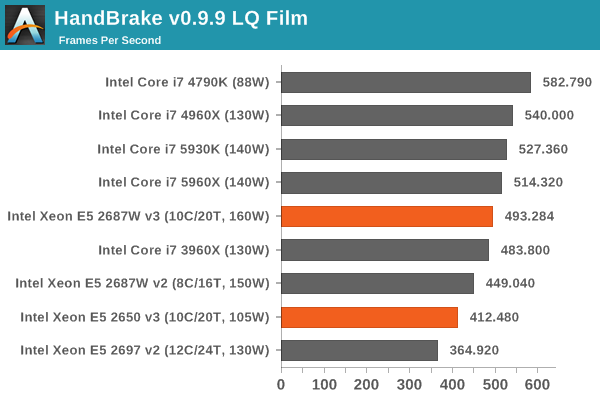
Low quality conversion loves faster individual cores, hence the W processor wins out due to its higher full-load frequency. Nonetheless, the fast consumer grade processors win here by a large margin.
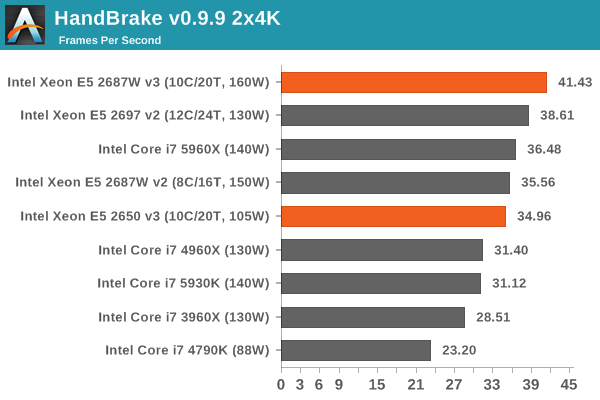
In full double-4K mode, the balance of cores, frequency and architecture upgrade puts the E5-2687W v3 above the 12-core E5-2697 v2.
Agisoft Photoscan – 2D to 3D Image Manipulation: link
Agisoft Photoscan creates 3D models from 2D images, a process which is very computationally expensive. The algorithm is split into four distinct phases, and different phases of the model reconstruction require either fast memory, fast IPC, more cores, or even OpenCL compute devices to hand. Agisoft supplied us with a special version of the software to script the process, where we take 50 images of a stately home and convert it into a medium quality model. This benchmark typically takes around 15-20 minutes on a high end PC on the CPU alone, with GPUs reducing the time.

Dolphin Benchmark: link
Many emulators are often bound by single thread CPU performance, and general reports tended to suggest that Haswell provided a significant boost to emulator performance. This benchmark runs a Wii program that raytraces a complex 3D scene inside the Dolphin Wii emulator. Performance on this benchmark is a good proxy of the speed of Dolphin CPU emulation, which is an intensive single core task using most aspects of a CPU. Results are given in minutes, where the Wii itself scores 17.53 minutes.
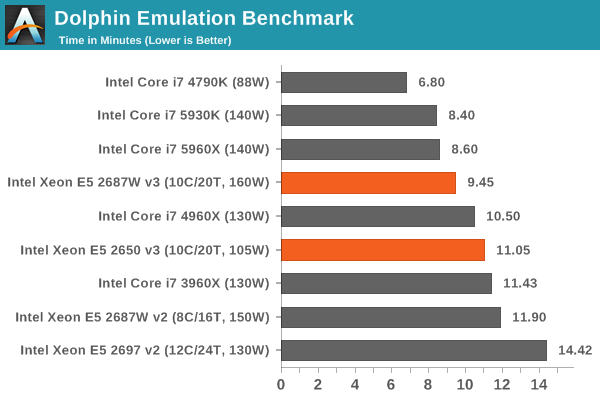
A single emulation instance benefits from a fast single core.
WinRAR 5.0.1: link
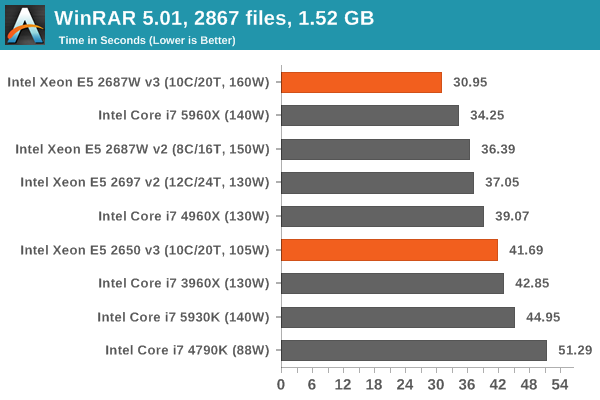
WinRAR seems to enjoy Haswell-EP over Ivy-EP, although it stills needs a high frequency to achieve top speeds.
PCMark8 v2 OpenCL
A new addition to our CPU testing suite is PCMark8 v2, where we test the Work 2.0 suite in OpenCL mode.
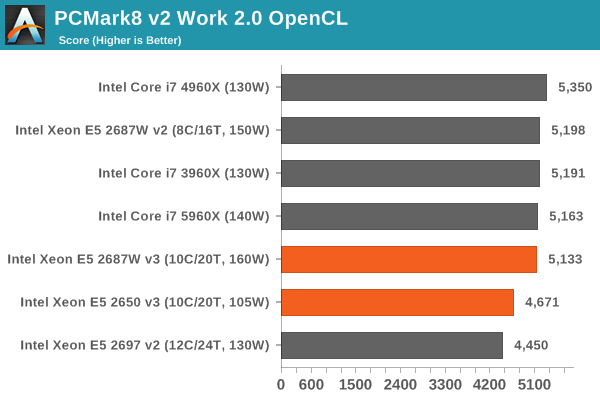
Hybrid x265
Hybrid is a new benchmark, where we take a 4K 1500 frame video and convert it into an x265 format without audio. Results are given in frames per second.
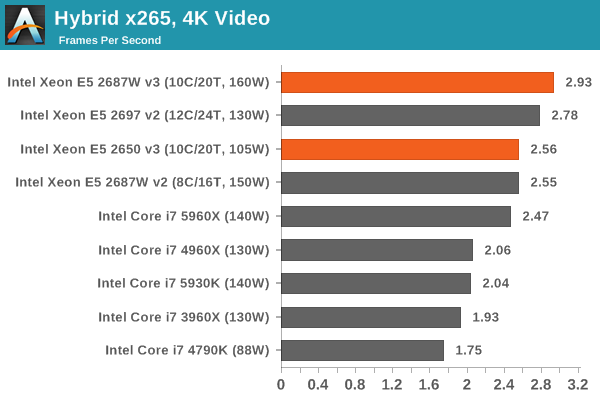
Hybrid also takes advantage of the new architecture, giving a 5% advantage to the E5-2687W v3 despite two fewer cores.
Cinebench R15
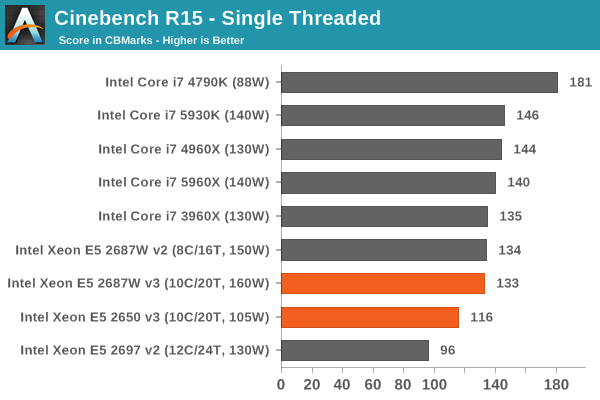
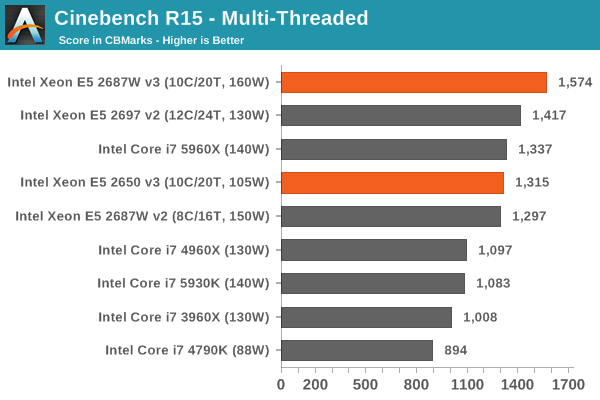
3D Particle Movement
3DPM is a self-penned benchmark, taking basic 3D movement algorithms used in Brownian Motion simulations and testing them for speed. High floating point performance, MHz and IPC wins in the single thread version, whereas the multithread version has to handle the threads and loves more cores.


FastStone Image Viewer 4.9
FastStone is the program I use to perform quick or bulk actions on images, such as resizing, adjusting for color and cropping. In our test we take a series of 170 images in various sizes and formats and convert them all into 640x480 .gif files, maintaining the aspect ratio. FastStone does not use multithreading for this test, and results are given in seconds.
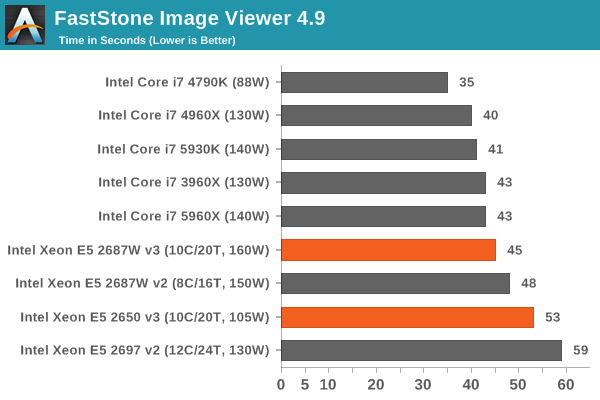
Web Benchmarks
General usability is a big factor of experience, especially as we move into the HTML5 era of web browsing. For our web benchmarks, we take four well known tests with Chrome 35 as a consistent browser.
Sunspider 1.0.2
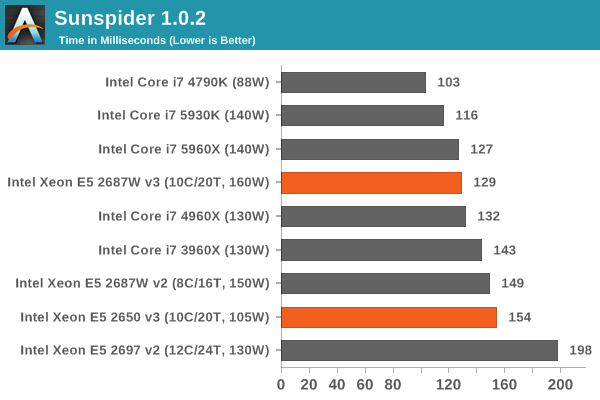
Mozilla Kraken 1.1
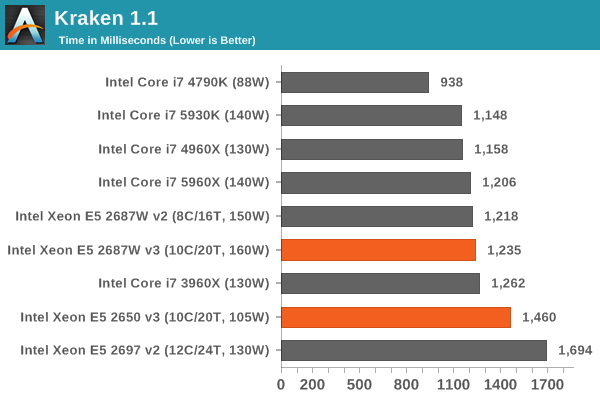
WebXPRT

Google Octane v2











27 Comments
View All Comments
personne - Monday, October 13, 2014 - link
This review should be called Intel Xeon E5-2687W v3 and E5-2650 v3 on Windows Review. I'd think a large number of these servers would be used for other operating systems.Ian Cutress - Monday, October 13, 2014 - link
I have some Linux benchmarks in the pipeline that I'm testing but aren't ready for prime time yet.I'll need to get some CPUs back in my office to test with that though, these Xeons are usually only loaner samples and it gets difficult to retest them.
personne - Monday, October 13, 2014 - link
Thanks. I admit it really aggravates me, in 2014, to see screenshots of applications as some sort of qualifier. So I hope you can generate some really useful discrete data for a critical audience.Marthisdil - Monday, October 13, 2014 - link
I think a large number of these servers will be used in ESX (or other hypervisor) hosts, so these benchmarks don't really mean a ton.Flunk - Tuesday, October 14, 2014 - link
This review is all workstation loads, so it's not that helpful even if you are using Windows. I think most of the Windows Systems these very pricey Xeons end up in will be servers. IIS, database and active directory performance testing would be more appropriate.elerick - Monday, October 13, 2014 - link
I do find some value in the benchmarks proved by this review. For a review to include a high end workstation with DDR4 to have gaming benchmarks it proves that game engines do not take advantage of the extra bandwidth. The only factor is CPU architecture @ frequency + graphics cards.I would have liked to see how this CPU handles server applications and storage such as ZFS. More and more converged infrastructure is becoming hardware vendor agnostic ESXi 6 has some pretty cool features that make sense with Super Micro hardware taking advantage of the latest CPU
iwod - Monday, October 13, 2014 - link
I think next year Xeon will be much more interesting with 14nm. I am hoping to see an increase from 12 to 16, and 18 to 24/32 Core. Along with much cheaper DDR4.Jon Tseng - Monday, October 13, 2014 - link
Hey Ian any more thoughts on power consumption vs. Ivy Bridge in day-to-day use, not just load.To me the obvious advantage of Grantley on paper is bringing all that Haswell power-gating/idle goodness to the server environment. The technology which lets Haswell spin out battery life in a laptop should also deliver energy and cost savings in a DC - which matters given power consumption (this is assuming your DC has decent periods of under-utilization - i.e. not an HPC plant!).
Curious if any thoughts/data on this... J
isa - Monday, October 13, 2014 - link
I feel personally threatened by the "idea-limited" constraint. I resemble that remark. But I compensate with kool LEDs on my PC.Carl Bicknell - Monday, October 13, 2014 - link
One thing that really needs spelling out is the clock speed under full load on all cores. That's much more informative than giving the default or the range.For the 2687W it's 3.2GHz default, and 3.4Ghz with turbo on all cores. That's pretty disappointing Intel.